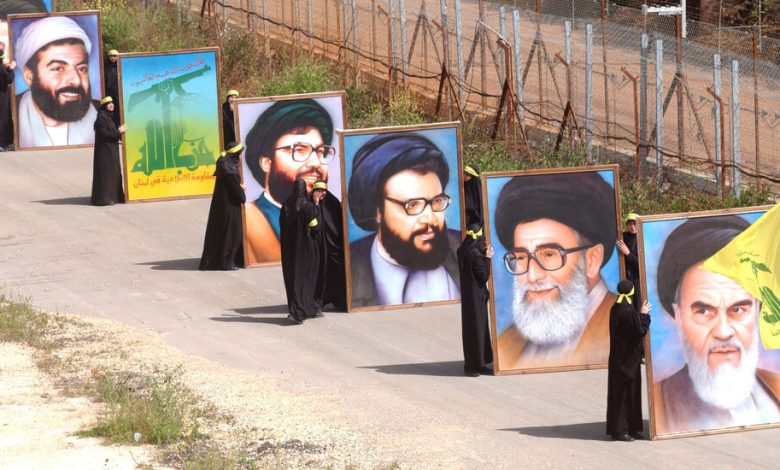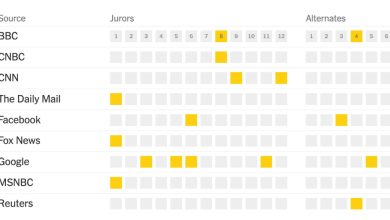The Proxy Forces Iran Has Assembled Across the Middle East

For decades, the Shiite Muslim ayatollahs who came to power in Iran through the 1979 Islamic Revolution have worked to build an arc of like-minded proxy forces across the Middle East.
Training and arming extremist, nonstate militia groups throughout the region have been pillars of Iran’s foreign and security policy. What the Islamic Republic calls the “Axis of Resistance,” others often describe as a “Shiite Crescent” that stretches from Yemen on the southern Arabian Peninsula through Iraq, Syria and Lebanon, and back down to the Gaza Strip.
Hamas, which controls the strip and is a rare Sunni Muslim organization among mostly Shiite militants, catapulted Iran and its allies back onto the global radar on Oct. 7 with a brutal cross-border attack on Israel. In response, Israel launched a blockade and a sustained bombing campaign that has devastated Gaza, as well as preparations for a possible ground invasion, sparking rumblings about a regional conflagration.
The degree to which Iran holds direct influence over this loose regional network is murky.Here is a summary of the main proxy forces and their locations in the region.
LEBANON
Hezbollah, Arabic for the “Party of God,” emerged in the 1980s from the chaos of Lebanon’s long civil war to become one of the most powerful forces in the region.
When Israel pulled back from most of neighboring Lebanon three years after its 1982 invasion, its army remained along a thin border strip. But the toll from constant clashes with Hezbollah forced a withdrawal in 2000. Hezbollah fought a 33-day war with Israel again in 2006, and there have been almost daily exchanges of fire since Oct. 7.
Iran is believed to have supplied Hezbollah with powerful missiles that could strike most Israeli cities, and Israel would be hard pressed to fight in both Gaza and in the north if Hezbollah launched a significant campaign. Prime Minister Benjamin Netanyahu of Israel has vowed devastating consequences for any such effort.
Aside from being a Shiite militia, however, Hezbollah is also a political party seeking popular appeal among other Lebanese sects. So despite Hezbollah’s virulent anti-Israel rhetoric, a new war would wreak havoc on a country already reeling from an unprecedented economic and infrastructure crisis and risk angering the bulk of Lebanon’s estimated 5.5 million population.
SYRIA
The ruling Assad family, members of the minority Alawite sect, a splinter off Shiism, has long bolstered its grip at home by allying itself with Iran. That alliance proved especially useful after 2011, when President Bashar al-Assad faced an antigovernment uprising and eventually a civil war with extremist Sunni Muslim forces.
Iran supplied militia troops — Israel accused it of deploying as many as 80,000 men — to buttress Syrian ground forces, while Russia provided air power. Hezbollah also dispatched fighters from Lebanon.
The 1974 cease-fire line between Israel and Syria in the Israeli-occupied Golan Heights remained quiet for decades, although there have been occasional exchanges of fire since the uprising began. In recent days, Israel has launched airstrikes to respond to artillery fire from Syria, which opposition analysts said was most likely fired by Hezbollah.
The Assad regime has long supported radical Palestinian factions, but Hamas broke with Damascus in 2012 over the widespread arrest, torture and killing of countless Sunni Muslims insurgents. Mr. Assad is unlikely to want to open another front to help Hamas, especially since he continues to struggle to gain control over his country.
The Biden administration, meanwhile, has blamed Iran’s proxy forces in Syria and Iraq for attacks against U.S. military targets. And early on Friday, the United States, which has deployed two aircraft carrier groups to the eastern Mediterranean, announced that it had carried out two airstrikes against military facilities used by Iran’s Islamic Revolutionary Guards Corps in Syria.
The air raids were meant to signal to Tehran it must rein in attacks against U.S. military facilities, U.S. officials said.
IRAQ
One unintended consequence of the U.S. invasion of Iraq in 2003 was that Iran was able to extend its influence deep inside its onetime enemy, setting up loyal militias, gaining wide political influence and reaping economic benefits.
Iraq and Iran are the two largest Middle Eastern countries with a Shiite Muslim majority, and they also emerged from the war empowered across the region in a way that unnerved their ancient sectarian rivals, the Sunni Muslims, who dominate most Arab countries.
The effort to first drive out the American forces and then the Islamic State terrorist group allowed Iran and its allies to hone the use of militias and violence to attain their goals.
After rocket and drone attacks from Iran-backed militants last week, 19 U.S. troops based in Iraq and Syria suffered traumatic brain injuries, the Pentagon said on Thursday.
YEMEN
In the Persian Gulf, the monarchies ruling Saudi Arabia and Bahrain have accused Iran of trying to foster instability by encouraging uprisings among the Shiite majority in the tiny island nation of Bahrain and the Shiite minority concentrated along Saudi Arabia’s oil-rich eastern coast. In both countries, dissent was put down with brutal force.
Iran succeeded, however, in Yemen, where the militant Houthi Shiite movement armed by Tehran has come to dominate the country in an extended proxy war, pitting Iran against Saudi Arabia and the United Arab Emirates.
The movement emerged in strength after 2014 as a political and armed organization whose leadership comes from the Houthi tribe, former rulers of northern Yemen whose faith is a Shiite offshoot known as Zaidi Shiism. The movement modeled itself on Hezbollah.
The Brookings Institution estimated that the war — which has created one of the worst humanitarian catastrophes in the world — costs Tehran a few million dollars per month, while it costs Riyadh $6 billion per month.
THE GAZA STRIP
Iran has long been engaged in a shadow war with Israel, its designated enemy. But the degree to which Tehran helped Hamas carry out the recent attack on Israel remains unclear. Intelligence analysts in Washington and Tel Aviv believe that Tehran at least provided the means.
Iran’s supreme leader, Ayatollah Ali Khamenei, and other senior Iranian officials have all applauded Hamas, and Iran has threatened to widen its habitual cat-and-mouse attacks into an actual war unless Israel halts its retaliatory attacks on Gaza.
One goal of the bloody Hamas incursion, which killed at least 1,400 Israelis, with at least 229 more taken hostage, could well have been to disrupt a brewing peace agreement between Israel and Saudi Arabia, which would have left Iran isolated in the region.
The death toll in Gaza, which Palestinian health officials put at more than 6,700, has sparked street protests across the Arab world, and if they escalate, they could threaten the stability of autocratic rulers in Egypt, Jordan and other states, which would serve Iran’s interests.
On Friday, Egypt’s state news media said that at least six people had been injured by two drones that flew from the southern part of the Red Sea to the north, hitting Taba and Nuwaiba, Sinai resort towns not far from Israel and Gaza.
Egypt did not specify from where they had been launched, but the United States said last week that a navy warship in the northern Red Sea had intercepted projectiles possibly launched toward Israel by Yemen’s armed Houthi militia.




